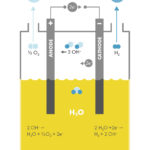Saviors and Saboteurs in Alternative Energy
John Petersen Last week Societe Generale published a thematic research report titled "A new world order, when demand overtakes supply" which examines the macro-economic and demographic trends that will transform the global economy over the next 20 years. It mirrored the theme of Jeremy Grantham's April 2011 quarterly letter titled "Time to Wake Up: Days of Abundant Resources and Falling Prices Are Over Forever" and did a great job of summarizing an issue I touched on in "How PHEVs and EVs Will Sabotage America's Drive For Energy Independence." In the words of Societe Generale: "So, while...
The Race For Silicon Anodes
Graphite is the most widely used material for battery anodes. The anode is the positively charged electron collector in a battery. It collects and accelerates the electronics emitted by the battery’s cathode. Graphite gets the anode job because it is has excellent electric conductivity and resists heat and corrosion. Plus it is light weight, soft and malleable.
As satisfied as manufacturers might be with graphite anodes, none would balk at an alternative material that boosts battery performance or reduces cost. Scientists believe battery capacity can be increased as much as ten times by using silicon for anodes. It requires six atoms of carbon to bind one...
Grid-Based Energy Storage; Notes, Questions and Heresies from Storage Week
John Petersen Last week I had the pleasure of participating as a panelist in Infocast’s Storage Week and attending four days of presentations by industry executives, national thought leaders and policymakers. While most of the presentations were too detailed and specific for a blog about energy storage stocks, there were a few high-level discussions that may be interesting to readers and while I'll never qualify as a journalist I can at least share some of the thoughts I jotted down. Storage for Integration of Renewables Two of the most important presentations came from Dr....
BCON up over 147% today
Beacon Power Corp (BCON) was up over 147% at the close today. This move was primarily based on two project wins. One with the New York State Energy Research and Development Authority and the other with the California Energy Commission. The projects would have Beacon Power provide grid frequency regulation and reactive power by utilizing its flywheel energy storage system. The final terms and conditions of the projects have not been disclosed.
Is Maxwell Technologies the Next China Victim? Not So Fast
Tom Konrad CFA Nightmare or business opportunity? A Lishen-branded Ultracapacitor, with Maxwell electrode. Photo credit: Wedbush On May 25, research firm Wedbush released the green stock investor’s worst nightmare. That is the specter of Chinese competition. Why are solar stocks down 75% (as measured by the Guggenhein Solar ETF, NYSE:TAN) since the start of 2011? Chinese competition, leading to overcapacity and an industry where most companies are losing money, even on greatly increased volumes. Why are wind stocks down41% (as measured by the First Trust Global...
Maxwell Stakes its Claim in a $2.7 Billion Niche Market
John Petersen Last Wednesday Maxwell Technologies (MXWL) announced the launch of a new ultracapacitor product that insures reliable engine starting for commercial trucks and other heavy vehicles. According to the Energy Information Administration, the existing US fleet includes 4.2 million heavy-duty diesel trucks. All of these vehicles are subject to strict anti-idling laws and regulations that strain their battery systems and increase the risk that the engine won't be able to start when it needs to. While a dead battery is a pain for the average consumer, it can cause a world of problems for a commercial truck...
Maxwell Technologies (MXWL): Buy or Steal?
Tom Konrad CFA Confusion reigned following Maxwell Technologies’ (NASD:MXWL) earnings call Thursday night. What would be the impact of the company’s reduced sales growth guidance on the stocks value? The Bulls At below $10, I thought the stock was “a steal” and it would quickly rise by the end of the day. CEO David Schramm and three other insiders apparently agreed with me, since they bought 48,000 shares at prices between $9 and $10.20 early the following week. Also on the bullish side was Needham & Co analyst Micheal Lew,...
Hydrogenics Corp: Splitting Water
by Debra Fiakas, CFA Most investors, if they have heard of Hydrogenics Corporation (HYGS: Nasdaq) at all, consider them a fuel cell producer. However, about two-thirds of the company’s revenue comes from the design and manufacture of hydrogen generation products based on water electrolysis technology - a somewhat unique, but valuable electrochemical technology that could make important contributions to the world’s future energy base. Electrolysis or the splitting of water molecules using an electric current produces hydrogen and oxygen - two elements that have market potential in a variety of industrial and power markets. It stands in...
Grid-based Energy Storage: Widely Misunderstood Challenges and Opportunities
John Petersen The most widely misunderstood subject in the field of energy storage is the potential for grid-based applications. They fire the imagination because the grid is so pervasive and the need is so great. They also present immense challenges to storage technology developers because the fundamental economic value per unit of grid-based energy storage is very low. While the subject of grid-based storage provides rich fodder for media reports and political posturing, the reality bears little relation to the perception. On March 9th, Lux Research published a sorely needed reality check in a new report titled "Grid...
What I Learned During Last Week’s Visit With ePower
John Petersen Last week I spent a couple days with ePower Engine Systems working my way through a variety of business and technical due diligence issues. As always happens with new clients, it was a full immersion course in how ePower’s technology works, what the documented performance of the current tractor is, and how that performance is expected to change as ePower: transitions from a four cylinder engine designed for stationary use to an EPA compliant six cylinder engine designed for the trucking industry; automates a new charge control system that will opportunistically charge the batteries in...
Introduction to Electrolyzer Technologies
by Ishaan Goel
Hydrogen has become increasingly prominent as a potential carbon-free fuel, for both automobiles and providing electricity to buildings. It has direct applications in decarbonizing important industries like steel, and can serve as a storage medium for extra renewable energy over seasonal durations too.
Since hydrogen gas does not occur naturally in our atmosphere, its method of production is an essential component of the hydrogen economy. There are several such methods (discussed in detail here), but the one with least emissions involves using renewable power to run electrolyzers - devices that use electricity to convert water into hydrogen and...
How the Hydrogen Economy Works
One of the major movers in the Alternative Energy sector are stocks that pertain to Hydrogen production and conversion into energy. You can learn more about the Hydrogen economy at the excellent How Stuff Works website using the following link: How the Hydrogen Economy Works.
Hydrogenics: Will Hydrogen Skeptics Be Blown Away?
The hydrogen technology developer Hydrogenics Corporation (HYGS: Nasdaq) is taking on wind energy. The company’s fuel cell power systems for stand-by and site power sources, hydrogen generators for industrial situations, and energy storage and fuel solutions for fleet owners. Hydrogen has gained in popularity because it is a zero-emission fuel source when burned with oxygen. The energy efficiency of hydrogen as a transportation fuel is also enticing. An electric motor powered by hydrogen fuel cell is two to three times more efficient than an internal combustion engine running on gasoline.
Hydrogen is not without its critics. One of the criticisms is that hydrogen is not entirely a carbon-neutral...
An Elephant Hunter Explains Inflection Point Investing
John Petersen In "An Elephant Hunter Explains Market Dynamics" I discussed the two basic types of public companies; earnings-driven companies that are “bought” in top-tier weighing machine markets and event-driven companies that are “sold” in lower-tier voting machine markets. Today I'll get a bit more granular and show how "sold" companies usually fall into one of two discrete sub-classes that have a major impact on their stock market valuations. As a starting point, I'll ignore the China-based companies that are listed in the US because their quirky metrics would only confuse the analysis. Then I'll break...
Electro Energy, Inc. Successfully Integrates Patented Bipolar Battery Technology and Lithium Ion Technology
Electro Energy Inc (EEEI) announced it has successfully integrated its patented bipolar battery design with lithium ion technology to achieve a multi-cell prototype battery with increased discharge efficiency, reduced weight and volume, more flexible design, and lower manufacturing costs. This achievement combines, for the first time, proven bipolar wafer cell design with gel polymer electrolyte-based lithium ion (Li-ion) technology. The bipolar Li-ion (BP Li-ion) cells have the same positive attributes as Electro Energy's bipolar nickel-metal hydride (BP Ni-MH) design, which typically provides up to 50% more power, 30% lower volume and 25% lower manufacturing costs than competing technologies....
Can ZBB Grab a Piece of the Energy Storage Pie?
by Debra Fiakas CFA There are a lot of different technologies in the energy storage space. ZBB Energy (ZBB: NYSE) has staked its future on zinc bromide. Batteries using zinc-bromide consist of a zinc negative electrode and a bromine positive electrode with a porous separator in between them. Unlike conventional batteries, these electrodes do not take part in the reactions but merely serve as substrates for the energy reactions. Thus there is no loss of performance from repeated cycling causing electrode material deterioration. The zinc-bromine battery can provide two to three times the energy density...




